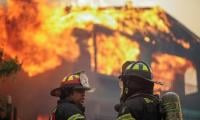Who will protect the environment?
As the pandemic continues to ravage through state after state, affecting millions of people, another catastrophe seems to be haunting humanity. This emerging threat – environmental disasters – is not new.
Scientists, activists, environmentalists and a tiny section of politicians have been making loud demands for the world to take this issue seriously but it seems the global political elite has chosen to serve the interest of the corporate world that is least bothered about environmental degradation and more immersed in the world of profit and money-making.
This indifferent attitude is pushing humanity towards a conflagration that will incinerate everything, leaving no trace of human existence and civilization. Reports after reports have suggested that we take urgent steps to address the issue of carbon emission that is playing havoc with the lives of millions, threatening the existence of this beautiful planet. But it seems the political elite does not have enough time to tackle this issue, which is not only affecting the global south but the advanced capitalist world as well.
The recent terrible wildfires in California should serve as a reminder that nobody is immune to the catastrophe that could be caused by rising temperatures. It is not only California but other parts of the US as well that have been ravaged by these raging fires. According to a report of the US government, “Over the past 10 years, there were an average of 64,100 wildfires annually and an average of 6.8million acres burned annually. In 2019, 50,477 wildfires burned 4.7 million acres nationwide, below the annual average for both statistics. More than half of the acreage burned in 2019 was in Alaska (2.5 million acres), which was the only area that experienced significantly above-average wildfire activity for the year.
“The 2015 fire season was the largest on record, with 10.1 million acres burned; more than half of these acres were in Alaska (5.1 million acres). As of October 1, 2020, over 44,000 wildfires have burned nearly 7.7 million acres this year. The nationwide preparedness level has been at the maximum level, since August 18, indicating a significant commitment of shared resources over a prolonged period. In 2019, 65 percent of the nationwide acreage burned by wildfires was on federal lands (3.1million acres; The other 35 percent of the acreage burned occurred on state, local, or privately owned lands but also accounted for 78 percent of the fires.”
Despite all this destruction, there are leaders like Donald Trump who not only pulled out of the Paris Agreement but are ready to sacrifice the very existence of human civilisation for the sake of corporate interests. He has not only denied the existence of environmental degradation but came up with policies that are likely to do more harm to our world.
Such fires are also wreaking havoc in Australia that has witnessed a number of fire incidents. Bushfires, in one of the largest countries of the world, killed around 33 people this year in January – including four firefighters – and more than 11 million hectares of bush, forest and parks across the country were burned. Although politicians tend to dismiss any link between these fires and environmental degradation, activists are adamant that these are the results of rising temperatures and carbon emission, arguing record-breaking temperatures and months of severe droughts sparked the series of massive fires.
It is not only these fires that are a matter of great concern but the shrinking forests in the world, the rainforest in the Amazon in particular, are also alarming those who love this planet and care about the life that it sustains. The reckless policies of the Brazilian government, critics claim, are pushing the Amazon towards destruction. A new report has claimed that the Amazon could be on the verge of losing its distinct nature and switching from a closed canopy rainforest to an open savannah with far fewer trees as a result of the climate crisis. Experts say rainforests are highly sensitive to changes in rainfall and moisture levels, and fires and prolonged droughts can result in areas losing trees and shifting to a savannah-like mix of woodland and grassland.
In the Amazon, such changes were known to be possible but thought to be many decades away but the new report offers a gloomy picture, asserting that the tipping point could be much closer than previously thought. The report reveals that as much as 40 percent of the existing rainforest is now at a point where it could exist as a savannah instead of as rainforest. The erratic president of Brazil, Jair Bolsonaro, was warned of such a scenario but it seems that – like his ideological brother Donald Trump – he does not subscribe to the ideas of environmentalists, asserting that everything is hunky dory. But the facts on the ground are different. There seems to be an exponential rise in fire hotspots in the Amazon. In fact, some experts claim this year’s fires are the worst in a decade with a 60 percent increase in fire hotspots compared with last year.
Trump has heaped scorn on those complaining about the possible consequences of environmental destruction but some states are taking this issue seriously. The EU is widely believed to be making efforts to address this grave danger but now China is also moving in the same direction making hectic efforts to tide over the crisis. Beijing is a big polluter but it is also undertaking steps to rid the world of this emerging threat. In fact, some estimates suggest that the country is leading the globe in clean energy. China seems to be determined to be carbon-free in the coming decades. This was also vowed by President Xi Jinping during an address to the UN General Assembly in September. And actions on the ground suggest that it is really happening.
Sceptics are reluctant to believe that the second economic power will actually translate its promise into action. They argue that the ‘authoritarian state’ is still the largest polluter, contributing around 28 percent of the world’s greenhouse gas emission, more than the US and the EU combined. They wonder how it will reduce 90 percent carbon emission, which would require very strong political will and could cause huge economic loss. They back their claims by facts stating that the giant country burns half of the world’s coal. Despite all its tall claims to care about environment, it is still planning to install more coal power plants. Such plants help it produce steel and cement which is crucial not only for its infrastructure projects but the economy as well.
China is also the largest importer of crude oil, which is one of the biggest culprits in fuelling carbon emission. Given all this, sceptics are not ready to believe that the country would undertake such an economically disastrous path.
But others point out that Beijing is the largest investor, producer and consumer of renewable energy with one out of every three solar panels and wind turbines installed in the most populous country, which is also home to half of the world’s electric passenger vehicles. This has created a ray of hope among environmentalists but such hope is premature if Beijing and the EU do not cooperate on this issue, forcing other states like the US and Russia to take the same path. If sincere efforts are made, China can become the global leader of the battle environmentalists have been waging for decades.
The writer is a freelance journalist.
Email: egalitarianism444@ gmail.com
-
 Prince Harry Risks Making King Charles Choose Between Queen Camilla And Military Duty
Prince Harry Risks Making King Charles Choose Between Queen Camilla And Military Duty -
 Inside How Kate Middleton Stayed Steady Amid Cancer And Royal Chaos
Inside How Kate Middleton Stayed Steady Amid Cancer And Royal Chaos -
 Kate Hudson Jokes She May Write A Script To Star Alongside This Actress
Kate Hudson Jokes She May Write A Script To Star Alongside This Actress -
 Kanye West's Wife Bianca Censori Shows Off Hidden Talent
Kanye West's Wife Bianca Censori Shows Off Hidden Talent -
 Kate Middleton Has Learnt Her 'lesson' After 'powering Through'
Kate Middleton Has Learnt Her 'lesson' After 'powering Through' -
 Will Prince Harry Be A Working Royal Again For Archie, Lilibet’s Royal Prospects? Expert Answers
Will Prince Harry Be A Working Royal Again For Archie, Lilibet’s Royal Prospects? Expert Answers -
 Chile In Danger: Deadly Wildfires Kill 20,forced 50,000 To Flee; President Declares ‘State Of Catastrophe’
Chile In Danger: Deadly Wildfires Kill 20,forced 50,000 To Flee; President Declares ‘State Of Catastrophe’ -
 Prince Harry’s Relationship With King Charles 'changes' With Archie, Lilibet’s UK Doors Opening
Prince Harry’s Relationship With King Charles 'changes' With Archie, Lilibet’s UK Doors Opening -
 Sara Waisglass Addresses Fans Concerns About Recasting In 'Ginny & Georgia'
Sara Waisglass Addresses Fans Concerns About Recasting In 'Ginny & Georgia' -
 Tim Allen Reflects On Stepping Into Mentorship During 'Home Improvement' Gig
Tim Allen Reflects On Stepping Into Mentorship During 'Home Improvement' Gig -
 Royal Tensions Rise As King Charles Navigates Prince Harry, William Feud
Royal Tensions Rise As King Charles Navigates Prince Harry, William Feud -
 Katie Bates Husband Travis Clark Confesses He Cheated On Her
Katie Bates Husband Travis Clark Confesses He Cheated On Her -
 Andrew Makes Life As Newly Stripped Commoner Offensive To The People
Andrew Makes Life As Newly Stripped Commoner Offensive To The People -
 Kansas Woman Loses $255,000 In Gold In FBI Impersonation Scam
Kansas Woman Loses $255,000 In Gold In FBI Impersonation Scam -
 Prince Harry Arrives In UK To Fight His Phone Hacking Case
Prince Harry Arrives In UK To Fight His Phone Hacking Case -
 Nick Jonas Attempts To Take Break From Jonas Brothers With Upcoming Solo Album?
Nick Jonas Attempts To Take Break From Jonas Brothers With Upcoming Solo Album?



